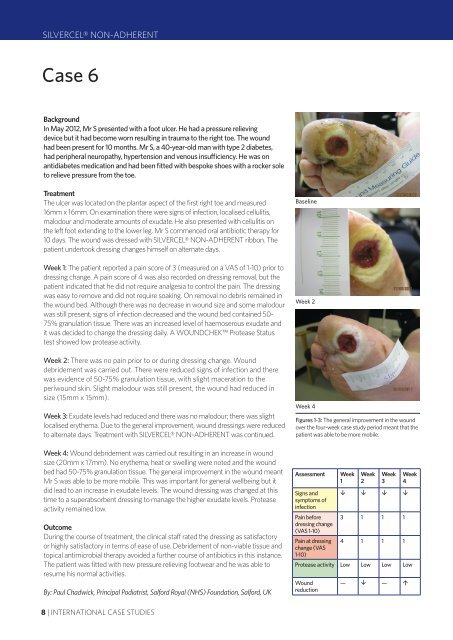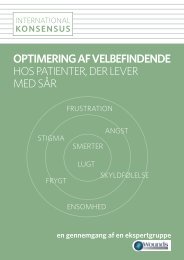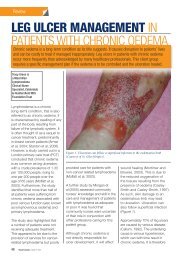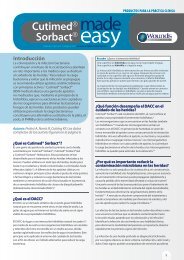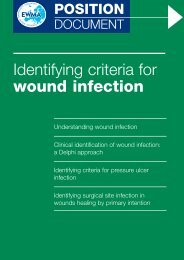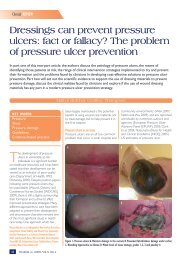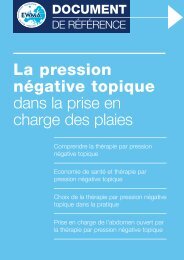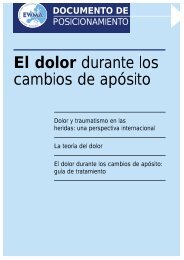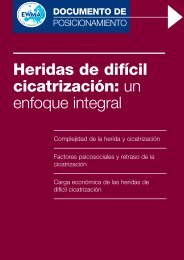VIEW PDF - Wounds International
VIEW PDF - Wounds International
VIEW PDF - Wounds International
You also want an ePaper? Increase the reach of your titles
YUMPU automatically turns print PDFs into web optimized ePapers that Google loves.
SILVERCEL® NON-ADHERENT<br />
Case 6<br />
Background<br />
In May 2012, Mr S presented with a foot ulcer. He had a pressure relieving<br />
device but it had become worn resulting in trauma to the right toe. The wound<br />
had been present for 10 months. Mr S, a 40-year-old man with type 2 diabetes,<br />
had peripheral neuropathy, hypertension and venous insufficiency. He was on<br />
antidiabetes medication and had been fitted with bespoke shoes with a rocker sole<br />
to relieve pressure from the toe.<br />
Treatment<br />
The ulcer was located on the plantar aspect of the first right toe and measured<br />
16mm x 16mm. On examination there were signs of infection, localised cellulitis,<br />
malodour and moderate amounts of exudate. He also presented with cellulitis on<br />
the left foot extending to the lower leg. Mr S commenced oral antibiotic therapy for<br />
10 days. The wound was dressed with SILVERCEL® NON-ADHERENT ribbon. The<br />
patient undertook dressing changes himself on alternate days.<br />
Week 1: The patient reported a pain score of 3 (measured on a VAS of 1-10) prior to<br />
dressing change. A pain score of 4 was also recorded on dressing removal, but the<br />
patient indicated that he did not require analgesia to control the pain. The dressing<br />
was easy to remove and did not require soaking. On removal no debris remained in<br />
the wound bed. Although there was no decrease in wound size and some malodour<br />
was still present, signs of infection decreased and the wound bed contained 50-<br />
75% granulation tissue. There was an increased level of haemoserous exudate and<br />
it was decided to change the dressing daily. A WOUNDCHEK Protease Status<br />
test showed low protease activity.<br />
Week 2: There was no pain prior to or during dressing change. Wound<br />
debridement was carried out. There were reduced signs of infection and there<br />
was evidence of 50-75% granulation tissue, with slight maceration to the<br />
periwound skin. Slight malodour was still present, the wound had reduced in<br />
size (15mm x 15mm).<br />
Week 3: Exudate levels had reduced and there was no malodour; there was slight<br />
localised erythema. Due to the general improvement, wound dressings were reduced<br />
to alternate days. Treatment with SILVERCEL® NON-ADHERENT was continued.<br />
Week 4: Wound debridement was carried out resulting in an increase in wound<br />
size (20mm x 17mm). No erythema, heat or swelling were noted and the wound<br />
bed had 50-75% granulation tissue. The general improvement in the wound meant<br />
Mr S was able to be more mobile. This was important for general wellbeing but it<br />
did lead to an increase in exudate levels. The wound dressing was changed at this<br />
time to a superabsorbent dressing to manage the higher exudate levels. Protease<br />
activity remained low.<br />
Outcome<br />
During the course of treatment, the clinical staff rated the dressing as satisfactory<br />
or highly satisfactory in terms of ease of use. Debridement of non-viable tissue and<br />
topical antimicrobial therapy avoided a further course of antibiotics in this instance.<br />
The patient was fitted with new pressure relieving footwear and he was able to<br />
resume his normal activities.<br />
By: Paul Chadwick, Principal Podiatrist, Salford Royal (NHS) Foundation, Salford, UK<br />
Baseline<br />
Week 2<br />
Week 4<br />
Figures 1-3: The general improvement in the wound<br />
over the four-week case study period meant that the<br />
patient was able to be more mobile.<br />
Assessment<br />
Signs and<br />
symptoms of<br />
infection<br />
Pain before<br />
dressing change<br />
(VAS 1-10)<br />
Pain at dressing<br />
change (VAS<br />
1-10)<br />
Week<br />
1<br />
Week<br />
2<br />
Week<br />
3<br />
<br />
3 1 1 1<br />
4 1 1 1<br />
Week<br />
4<br />
Protease activity Low Low Low Low<br />
Wound<br />
reduction<br />
— — <br />
8 | INTERNATIONAL CASE STUDIES


